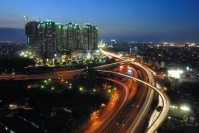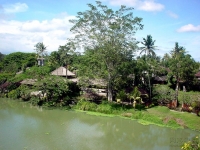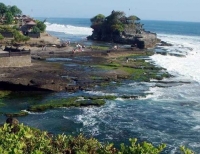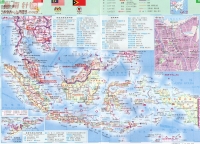| yìn dù ní xī yà Indonesia 首都:yǎ jiā dá 国家代码: id |
|
yìn dù ní xī yà gòng hé guó( TheRepublicofIndonesia)
dú lì rì: 8 yuè 1 7 rì(1 9 4 5 nián) guó qìng rì:8 yuè17 rì(1945 nián) guó qí: qí miàn yóu shàng hóng xià bái liǎng gè xiāng děng de héng cháng fāng xíng gòu chéng, cháng yǔ kuān zhī bǐ wéi 3 ∶ 2。 hóng sè xiàng zhēng yǒng gǎn hé zhèng yì, hái xiàng zhēng yìn dù ní xī yà dú lì yǐ hòu de fán róng chāng shèng; bái sè xiàng zhēng zì yóu、 gōng zhèng、 chún jié, hái biǎo dá liǎo yìn ní rén mín fǎn duì qīn lüè、 àihào hé píng de měi hǎo yuàn wàng。 guó huī: yóu yī zhǐ jīn sè de yīng、 yī miàn dùn hé yīng zhǎo zhuā zhe de yī tiáo shòu dài zǔ chéng。 yīng xiàng zhēng chuàng zào lì。 yīng liǎng yì gè yòu17 gēn yǔ máo, wěi yǔ8 gēn, zhè shì wèile jì niàn yìn dù ní xī yà de dú lì rì héng héng8 yuè17 rì。 yīng xiōng qián de dùn miàn yóu wǔ bù fēn zǔ chéng: hēi sè xiǎo dùn hé jīn huáng sè de wǔ jiǎo xīng dài biǎo zōng jiào xìn yǎng, yě xiàng zhēng “ pān chá xī lā ” héng héng yìn ní jiàn guó de wǔ xiàng jī běn yuán zé; shuǐ niú tóu xiàng zhēng zhù quán shǔ yú rén mín; róng shù xiàng zhēng mín zú yì shí; mián táo hé dào suì xiàng zhēng fù zú hé gōng zhèng; jīn sè shì huán xiàng zhēng rén dào zhù yì hé shì dài xiāng chuán。 dùn miàn shàng de cū hēi xiàn dài biǎo chì dào。 yīng zhǎo zhuā zhe de shòu dài shàng yòng yìn ní wén xiě zhe“ yì zhōng yòu tóng”。 guó jiā zhèng yào: zǒng tǒng sū xī luò · bān bāng · yóu duō yuē nuò( SusiloBambangYudhoyono),2 004 nián10 yuè dāng xuǎn; fù zǒng tǒng yōu sù fú · kǎ lā,2004 nián10 yuè dāng xuǎn; rén xié zhù xí xī dá yà tè · nǔ 'ěr · wǎ xī dé,2004 nián10 yuè dāng xuǎn。 zì rán dì lǐ: wèi yú yà zhōu dōng nán bù, dì kuà chì dào, shì shì jiè shàng zuì dà de qún dǎo guó jiā, yóu tài píng yáng hé yìn dù yáng zhī jiān17508 gè dà xiǎo dǎo yǔ zǔ chéng, qí zhōng yuē 6000 gè yòu rén jū zhù。 lù dì miàn jī wéi1 ,904 ,443 píng fāng gōng lǐ, hǎi yáng miàn jī3 ,166 ,163 píng fāng gōng lǐ( bù bāo kuò zhuān shǔ jīng jì qū) sù chēng qiān dǎo zhī guó。 běi bù de jiā lǐ màn dān dǎo yǔ mǎ lái xī yà jiē rǎng, xīn jǐ nèi yà dǎo yǔ bā bù yà xīn jǐ nèi yà xiāng lián。 dōng běi bù miàn lín fěi lǜ bīn, dōng nán bù shì yìn dù yáng, xī nán yǔ 'ào dà lì yà xiāng wàng。 hǎi 'àn xiàn zǒng cháng54716 gōng lǐ。 rè dài yǔ lín qì hòu, nián píng jūn wēn dù25 -27 ℃。 rén kǒu:2 .17 yì(2004 nián), wéi shì jiè dì sì rén kǒu dà guó。 yòu100 duō gè mín zú, qí zhōng zhǎo wā zú zhàn45 %, xùn tā zú zhàn14% , mǎdōu lā zú7 .5%, mǎ lái zú7 .5%, qí tā26%。 guān fāng yǔ yán wéi yìn dù ní xī yà yǔ。 mín zú yǔ yán hé fāng yán yuē300 zhǒng。 yuē87% de jū mín xìn fèng yī sī lán jiào, shì shì jiè shàng mù sī lín rén kǒu zuì duō de guó jiā,6 .1% de rén kǒu xìn fèng jī dū jiào xīn jiào,3 .6% xìn fèng tiān zhù jiào, qí yú xìn fèng yìn dù jiào、 fó jiào hé yuán shǐ bài wù jiào děng。 shǒu dū: yǎ jiā dá (Jakarta), wèi yú zhǎo wā dǎo shàng; rén kǒu yòu838 .5 wàn(2000 nián)。 xíng zhèng qū huá: gòng yòu yī jí xíng zhèng qū30 gè, bāo kuò yǎ jiā dá shǒu dū tè qū, rì rě hé yà qí dá lǔ sà lán2 gè dì fāng tè qū,27 gè shěng jí běi sū mén dá là、 xī sū mén dá là、 liào nèi、 zhàn bēi、 péng gǔ lǔ、 nán sū mén dá là、 nán bǎng、 bāng jiā- wù lǐ dòng、 xī zhǎo wā、 zhōng zhǎo wā、 dōng zhǎo wā、 wàn dān、 bā lí、 xī nǔ shā dēng jiā lā、 dōng nǔ shā dēng jiā lā、 běi mǎ lǔ gǔ、 nán mǎ lǔ gǔ、 bā bù yà、 běi sū lā wēi xī、 zhōng sū lā wēi xī、 dōng nán sū lā wēi xī、 nán sū lā wēi xī、 gē lún dǎ luò、 dōng jiā lǐ màn dān、 zhōng jiā lǐ màn dān、 nán jiā lǐ màn dān、 xī jiā lǐ màn dān。 èr jí xíng zhèng qū( xiàn / shì)410 gè。 jiǎn shǐ: gōng yuán3-7 shì jì jiàn lì liǎo yī xiē fēn sàn de fēng jiàn wáng guó。13 shì jì mò zhì14 shì jì chū, zài zhǎo wā jiàn lì liǎo yìn ní lì shǐ shàng zuì qiáng dà de má nuò bā xiē fēng jiàn dì guó。15 shì jì, pú táo yá、 xī bān yá hé yīng guó xiān hòu qīn rù。1596 nián hé lán qīn rù,1602 nián chéng lì jù yòu zhèng fǔ zhí quán de“ dōng yìn dù gōng sī”,1799 nián dǐ gǎi shè zhí mín zhèng fǔ。1942 nián rì běn zhàn lǐng yìn ní,1945 nián rì běn tóu jiàng hòu, yìn ní bào fā bā yuè gé mìng,8 yuè17 rì xuān bù dú lì, chéng lì yìn dù ní xī yà gòng hé guó。1947 nián hòu, hé lán yǔ yìn ní jīng guò duō cì zhàn zhēng hé xié shāng, yú1949 nián11 yuè qiān dìng yìn hé《 yuán zhuō huì yì xié dìng》。 gēn jù cǐ xié dìng, yìn ní yú tóng nián12 yuè27 rì chéng lì lián bāng gòng hé guó, cān jiā hé yìn lián bāng。1950 nián8 yuè yìn ní lián bāng yì yuàn tōng guò lín shí xiàn fǎ, zhèng shì xuān bù chéng lì yìn dù ní xī yà gòng hé guó。 zhèng zhì: shí xíng zǒng tǒng nèi gé zhì。 rén mín xié shāng huì yì shì guó jiā zuì gāo quán lì jī gòu, fù zé zhì dìng、 xiū gǎi yǔ bān bù xiàn fǎ hé guó jiā zǒng fāng zhēn zhèng cè, xuǎn jǔ zǒng tǒng, fù zǒng tǒng( 2004 nián hòu gǎi yóu quán mín zhí xuǎn), jiān dū hé píng jià zǒng tǒng zhí xíng guó jiā dà zhèng fāng zhēn qíng kuàng hé zài zǒng tǒng wéi bèi xiàn fǎ shí duì qí jìn xíng tánhé huò bà miǎn。 zhǐ shè zhōng yāng yī jí。 chéng yuán700 míng, rèn qī5 nián。 guó huì( quán chēng rén mín dài biǎo huì yì) shì guó jiā lì fǎ jī gòu, xíng shǐ xiū xiàn hé zhì dìng guó jiā dà zhèng fāng zhēn zhī wài de yī bān lì fǎ quán。 guó huì wú quán jiě chú zǒng tǒng zhí wù, zǒng tǒng yě bù néng xuān bù jiě sàn guó huì; dàn rú zǒng tǒng wéi fǎn xiàn fǎ huò rén xié jué yì, guó huì yòu quán jiàn yì rén xié zhuī jiū zǒng tǒng zé rèn。 gòng yòu yì yuán500 míng, jiān rèn rén xié chéng yuán。 rèn qī5 nián。 zǒng tǒng shì guó jiā yuán shǒu、 zhèng fǔ xíng zhèng shǒu nǎo hé wǔ zhuāng bù duì zuì gāo tǒng shuài, zhí jiē lǐng dǎo nèi gé, yòu quán dān dú bān bù zhèng lìng hé xuān bù guó jiā jǐn jí zhuàng tài fǎ lìng; duì wài xuān zhàn huò gòu hé děng。 zì 2004 nián qǐ, zǒng tǒng hé fù zǒng tǒng bù zài yóu rén mín xié shāng huì yì xuǎn jǔ chǎn shēng, gǎi yóu quán mín zhí xuǎn; zhǐ néng lián xuǎn lián rèn yī cì, měi rèn wǔ nián。 zǒng tǒng rèn mìng nèi gé, dàn xū zhēng dé guó huì tóng yì。 jīng jì: yìn ní shì dōng méng zuì dà de jīng jì tǐ。 nóng yè、 gōng yè hé fú wù yè jūn zài guó mín jīng jì zhōng fā huī zhòng yào zuò yòng, qí zhōng nóng yè hé yóu qì chǎn yè xì chuán tǒng zhī zhù chǎn yè。 yìn ní zī yuán fēng fù, kuàng chǎn zhù yào yòu shí yóu、 tiān rán qì、 méi、 xī、 lǚ fán tǔ、 niè、 tóng hé jīn、 yín děng。 yǐ tàn míng kuàng chǎn chǔ liàng wéi: shí yóu51 .2 yì tǒng、 tiān rán qì94 .75 wàn yì lì fāng chǐ, shì shì jiè zhù míng de yè huà tiān rán qì chū kǒu guó、 méi360 yì dūn, yà tài dì qū zhòng yào de chǎn méi guó hé shì jiè méi tàn chū kǒu guó。 dì rè zī yuán fēng fù, xiàng jiāo hé yē zǐ chǎn liàng jū shì jiè dì2 wèi, zōng lǘ yóu chǎn liàng zhàn shì jiè xū qiú liàng de2 /5。 sēn lín miàn jī wéi1 .45 yì gōng qǐng, zhàn guó tǔ miàn jī de74%。 yìn ní gōng yè fā zhǎn de fāng xiàng shì jiā qiáng wài xiàng xíng de zhì zào yè, zhù yào bù mén yòu zhì zào、 cǎi kuàng、 fǎng zhì、 qīng gōng、 jiā gōng yè děng。 nóng yè shì yìn ní de zhī zhù chǎn yè, bāo kuò cóng shì lín yè hé yú yè rén kǒu zài nèi, quán guó nóng yè rén kǒu yuē zhàn zǒng rén kǒu de59%。 gēng dì miàn jī5980 wàn gōng qǐng( bù bāo kuò bā bù yà shěng)。 yìn ní zhòng shì lǚ yóu yè, lǚ yóu yè yǐ chéng wéi yìn ní chuàng huì de zhù yào hángyè。 zhù yào lǚ yóu diǎn yòu bā lí dǎo、 pó luó fú tú fó tǎ、 yìn ní suō yǐng gōng yuán、 rì rě huáng gōng、 duō bā hú děng。 yìn ní hái shì yī gè huǒ shān zhī guó, gòng yòu400 duō zuò huǒ shān, qí zhōng huó huǒ shān100 duō zuò。 huò bì: lú bǐ ( dùn )>>> xīn wén chū bǎn: zhù yào yìn ní wén bào zhǐ yòu《 luó pán bào》、《 zhuān yè zhī shēng bào》、《 yìn ní méi tǐ bào》、《 gòng hé guó rì bào děng》、《 gé xīn zhī shēng bào》 hé《 yìn ní shāng bào》; yīng wén bào zhǐ yòu《 yǎ jiā dá yóu bào》、《 yìn ní guān chá jiā bào》 děng; zhōng wén bào zhǐ yuán lái zhǐ yòu zhèng fǔ zhù bàn de《 yìn dù ní xī yà rì bào》, jìn liǎng nián xīn chuàng jiàn de yòu《 huá wén yóu bào》( zhōng wén hé yìn ní wén hù yì)、《 shāng bào》、《 xīn shēng rì bào》、《 qiān dǎo rì bào》 děng。1937 nián chéng lì de 'ān tǎ lā tōng xùn shè shì guān fāng tōng xùn shè,1967 nián chéng lì de yìn ní mín zú tōng xùn shè wéi sī yíng jī gòu, chéng lì yú1945 nián9 yuè de yìn ní gòng hé guó guǎng bō diàn tái shì guó jiā diàn tái,1962 nián8 yuè17 rì zhèng shì yùn yíng de yìn ní gòng hé guó diàn shì tái wèiguó jiā diàn shì tái, sī yíng diàn shì tái yòu1988 nián11 yuè14 rì jiàn lì de yìn ní yīng jì diàn shì tái、1990 nián8 yuè chéng lì de tài yáng diàn shì tái, hé1991 nián1 yuè zǔ jiàn de jiào yù diàn shì tái,2000 nián10 yuè kāi shè de měi dū diàn shì tái shì yìn ní shǒu jiā xīn wén diàn shì tái, bìng kāi chuàng liǎo bō fàng zhōng wén xīn wén de xiān lì。 wài jiāo: fèng xíng dú lì zì zhù、 bù jié méng de jī jí wài jiāo zhèng cè, zhù zhāng píng děng、 xiāng hù zūn zhòng hé dà guó píng héng yuán zé, jī jí cānyù guó jì hé dì qū shì wù。 yǔ zhōng guó guān xì:1950 nián4 yuè13 rì, yìn dù ní xī yà tóng zhōng guó jiàn jiāo。1990 nián8 yuè8 rì, liǎng guó huī fù wài jiāo guān xì。1994 nián11 yuè, guó jiā zhù xí jiāng zé mín duì yìn ní jìn xíng guó shì fǎng wèn。1999 nián12 yuè, yìn ní zǒng tǒng wǎ xī dé duì zhōng guó jìn xíng guó shì fǎng wèn。2000 nián5 yuè, zhōng guó yǔ yìn ní zài běi jīng zhèng shì qiān shǔ《 zhōng huá rén mín gòng hé guó hé yìn dù ní xī yà gòng hé guó guān yú wèi lái shuāng biān hé zuò fāng xiàng de lián hé shēng míng》。2002 nián3 yuè, méi jiā wǎ dì zǒng tǒng duì zhōng guó jìn xíng guó shì fǎng wèn。2005 nián4 yuè13 rì, zhōng guó guó jiā zhù xí hú jǐn tāo yǔ yìn ní zǒng tǒng sū xī luò · bān bāng · yóu duō yuē nuò jìn rì hù zhì hè diàn, zhù hè liǎng guó jiàn jiāo55 zhōu nián(4 yuè13 rì)。 The Indonesian archipelago has been an important trade region since at least the seventh century, when the Srivijaya Kingdom formed trade links with China. Indonesian history has been influenced by foreign powers drawn to its natural resources. Under Indian influence, Hindu and Buddhist kingdoms flourished from the early centuries CE. Muslim traders brought Islam, and European powers fought one another to monopolize trade in the Spice Islands of Maluku during the Age of Discovery. Following three and a half centuries of Dutch colonialism, Indonesia secured its independence after World War II. Indonesia's history has since been turbulent, with challenges posed by natural disasters, corruption, separatism, a democratization process, and periods of rapid economic change. Across its many islands, Indonesia consists of distinct ethnic, linguistic, and religious groups. The Javanese are the largest and most politically dominant ethnic group. As a unitary state and a nation, Indonesia has developed a shared identity defined by a national language, a majority Muslim population, and a history of colonialism and rebellion against it. Indonesia's national motto, "Bhinneka tunggal ika" ("Unity in Diversity" lit. "many, yet one"), articulates the diversity that shapes the country. However, sectarian tensions and separatism have led to violent confrontations that have undermined political and economic stability. Despite its large population and densely populated regions, Indonesia has vast areas of wilderness that support the world's second highest level of biodiversity. The country is richly endowed with natural resources, yet poverty is a defining feature of contemporary Indonesia. The name Indonesia derives from the Latin Indus, meaning "India", and the Greek nesos, meaning "island". The name dates to the 18th century, far predating the formation of independent Indonesia. In 1850, George Earl, an English ethnologist, proposed the terms Indunesians — and, his preference, Malayunesians — for the inhabitants of the "Indian Archipelago or Malayan Archipelago". In the same publication, a student of Earl's, James Richardson Logan, used Indonesia as a synonym for Indian Archipelago. However, Dutch academics writing in East Indies publications were reluctant to use Indonesia. Instead, they used the terms Malay Archipelago (Maleische Archipel); the Netherlands East Indies (Nederlandsch Oost Indië), popularly Indië; the East (de Oost); and even Insulinde. From 1900, the name Indonesia became more common in academic circles outside the Netherlands, and Indonesian nationalist groups adopted it for political expression. Adolf Bastian, of the University of Berlin, popularized the name through his book Indonesien oder die Inseln des Malayischen Archipels, 1884–1894. The first Indonesian scholar to use the name was Suwardi Suryaningrat (Ki Hajar Dewantara), when he established a press bureau in the Netherlands with the name Indonesisch Pers-bureau in 1913. History As early as the first century CE Indonesian vessels made trade voyages as far as Africa. Picture: a ship carved on Borobudur, circa 800 CE.Fossilized remains of Homo erectus, popularly known as the "Java Man", suggest that the Indonesian archipelago was inhabited two million to 500,000 years ago. Austronesian people, who form the majority of the modern population, migrated to South East Asia from Taiwan. They arrived in Indonesia around 2000 BCE, and confined the native Melanesian peoples to the far eastern regions as they expanded. Ideal agricultural conditions, and the mastering of wet-field rice cultivation as early as the eighth century BCE, allowed villages, towns, and small kingdoms to flourish by the first century CE. Indonesia's strategic sea-lane position fostered inter-island and international trade. For example, trade links with both Indian kingdoms and China were established several centuries BCE. Trade has since fundamentally shaped Indonesian history. The nutmeg plant is native to Indonesia's Banda Islands. Once one of the world's most valuable commodities, it drew the first European colonial powers to Indonesia.From the seventh century CE, the powerful Srivijaya naval kingdom flourished as a result of trade and the influences of Hinduism and Buddhism that were imported with it. Between the eighth and 10th centuries CE, the agricultural Buddhist Sailendra and Hindu Mataram dynasties thrived and declined in inland Java, leaving grand religious monuments such as Sailendra's Borobudur and Mataram's Prambanan. The Hindu Majapahit kingdom was founded in eastern Java in the late 13th century, and under Gajah Mada, its influence stretched over much of Indonesia; this period is often referred to as a "Golden Age" in Indonesian history. Although Muslim traders first traveled through South East Asia early in the Islamic era, the earliest evidence of Islamized populations in Indonesia dates to the 13th century in northern Sumatra. Other Indonesian areas gradually adopted Islam, and it was the dominant religion in Java and Sumatra by the end of the 16th century. For the most part, Islam overlaid and mixed with existing cultural and religious influences, which shaped the predominant form of Islam in Indonesia, particularly in Java. The first Europeans arrived in Indonesia in 1512, when Portuguese traders, led by Francisco Serrão, sought to monopolize the sources of nutmeg, cloves, and cubeb pepper in Maluku. Dutch and British traders followed. In 1602 the Dutch established the Dutch East India Company (VOC) and became the dominant European power. Following bankruptcy, the VOC was formally dissolved in 1800, and the government of the Netherlands established the Dutch East Indies as a nationalized colony. For most of the colonial period, Dutch control over these territories was tenuous; only in the early 20th century did Dutch dominance extend to what was to become Indonesia's current boundaries. The Japanese invasion and subsequent occupation during World War II ended Dutch rule, and encouraged the previously suppressed Indonesian independence movement. Two days after the surrender of Japan in August 1945, Sukarno, an influential nationalist leader, declared independence and was appointed president. The Netherlands tried to reestablish their rule, and an armed and diplomatic struggle ended in December 1949, when in the face of international pressure, the Dutch formally recognized Indonesian independence (with the exception of The Dutch territory of West New Guinea, which was incorporated following the 1962 New York Agreement, and UN—mandated Act of Free Choice). Sukarno, Indonesia's founding presidentSukarno moved from democracy towards authoritarianism, and maintained his power base by balancing the opposing forces of the Military, Islam, and the Communist Party of Indonesia (PKI). An attempted coup on 30 September 1965 was countered by the army, who led a violent anti-communist purge, during which the PKI was blamed for the coup and effectively destroyed. Between 500,000 and one million people were killed. The head of the military, General Suharto, out-maneuvered the politically weakened Sukarno, and was formally appointed president in March 1968. His New Order administration was supported by the US government, and encouraged foreign direct investment in Indonesia, which was a major factor in the subsequent three decades of substantial economic growth. However, the authoritarian "New Order" was widely accused of corruption and suppression of political opposition. In 1997 and 1998, Indonesia was the country hardest hit by the Asian Financial Crisis. This increased popular discontent with the New Order and led to popular protests. Suharto resigned on 21 May 1998. In 1999, East Timor voted to secede from Indonesia, after a twenty-five-year military occupation that was marked by international condemnation of often brutal repression of the East Timorese. The Reformasi era following Suharto's resignation, has led to a strengthening of democratic processes, including a regional autonomy program, and the first direct presidential election in 2004. Political and economic instability, social unrest, corruption, and terrorism have slowed progress. Although relations among different religious and ethnic groups are largely harmonious, acute sectarian discontent and violence remain problems in some areas. A political settlement to an armed separatist conflict in Aceh was achieved in 2005. Government and politics Indonesia is a republic with a presidential system. As a unitary state, power is concentrated in the national government. Following the resignation of President Suharto in 1998, Indonesian political and governmental structures have undergone major reforms. Four amendments to the 1945 Constitution of Indonesia have revamped the executive, judicial, and legislative branches. The president of Indonesia is the head of state, commander-in-chief of the Indonesian Armed Forces, and the director of domestic governance, policy-making, and foreign affairs. The president appoints a council of ministers, who are not required to be elected members of the legislature. The 2004 presidential election was the first in which the people directly elected the president and vice president. The president may serve a maximum of two consecutive five-year terms. A session of the People's Representative Council in JakartaThe highest representative body at national level is the People's Consultative Assembly (MPR). Its main functions are supporting and amending the constitution, inaugurating the president, and formalizing broad outlines of state policy. It has the power to impeach the president. The MPR comprises two houses; the People's Representative Council (DPR), with 550 members, and the Regional Representatives Council (DPD), with 168 members. The DPR passes legislation and monitors the executive branch; party-aligned members are elected for five-year terms by proportional representation. Reforms since 1998 have markedly increased the DPR's role in national governance. The DPD is a new chamber for matters of regional management. Most civil disputes appear before a State Court; appeals are heard before the High Court. The Supreme Court is the country's highest court, and hears final cassation appeals and conducts case reviews. Other courts include the Commercial Court, which handles bankruptcy and insolvency; a State Administrative Court to hear administrative law cases against the government; a Constitutional Court to hear disputes concerning legality of law, general elections, dissolution of political parties, and the scope of authority of state institutions; and a Religious Court to deal with specific religious cases. Foreign relations and military In contrast to Sukarno's anti-imperialistic antipathy to western powers and tensions with Malaysia, Indonesia's foreign relations since the Suharto "New Order" have been based on economic and political cooperation with Western nations. Indonesia maintains close relationships with its neighbors in Asia, and is a founding member of ASEAN and the East Asia Summit. The nation restored relations with the People's Republic of China in 1990 following a freeze in place since anti-communist purges early in the Suharto era. Indonesia has been a member of the United Nations since 1950, and was a founder of the Non-Aligned Movement (NAM) and the Organisation of the Islamic Conference (OIC). Indonesia is signatory to the ASEAN Free Trade Area agreement, and a member of OPEC, the Cairns Group, and the WTO. Indonesia has received humanitarian and development aid since 1966, in particular from the United States, western Europe, Australia, and Japan. National flags at the site of the 2002 terrorist bombing in Kuta, BaliThe Indonesian Government has worked with other countries to apprehend and prosecute perpetrators of major bombings linked to militant Islamism and Al-Qaeda. The deadliest killed 202 people (including 164 international tourists) in the Bali resort town of Kuta in 2002. The attacks, and subsequent travel warnings issued by other countries, severely damaged Indonesia's tourism industry and foreign investment prospects. Indonesia's 300,000-member armed forces (TNI) include the Army (TNI-AD), Navy (TNI-AL, which includes marines), and Air Force (TNI-AU). The army has about 233,000 active-duty personnel. Defense spending in the national budget was 4% of GDP in 2006, and is controversially supplemented by revenue from military commercial interests and foundations. In the post-Suharto period since 1998, formal TNI representation in parliament has been removed; though curtailed, its political influence remains extensive. Separatist movements in the provinces of Aceh and Papua have led to armed conflict, and subsequent allegations of human rights abuses and brutality from all sides. Following a sporadic thirty year guerrilla war between the Free Aceh Movement (GAM) and the Indonesian military, a ceasefire agreement was reached in 2005. In Papua, there has been a significant, albeit imperfect, implementation of regional autonomy laws, and a reported decline in the levels of violence and human rights abuses, since the presidency of Susilo Bambang Yudhoyono. Administrative divisions Provinces of IndonesiaAdministratively, Indonesia consists of 33 provinces, five of which have special status. Each province has its own political legislature and governor. The provinces are subdivided into regencies (kabupaten) and cities (kota), which are further subdivided into subdistricts (kecamatan), and again into village groupings (either desa or kelurahan). Following the implementation of regional autonomy measures in 2001, the regencies and cities have become the key administrative units, responsible for providing most government services. The village administration level is the most influential on a citizen's daily life, and handles matters of a village or neighborhood through an elected lurah or kepala desa (village chief). The provinces of Aceh, Jakarta, Yogyakarta, Papua, and West Papua have greater legislative privileges and a higher degree of autonomy from the central government than the other provinces. The Acehnese government, for example, has the right to create an independent legal system; in 2003, it instituted a form of Sharia (Islamic law). Yogyakarta was granted the status of Special Region in recognition of its pivotal role in supporting Indonesian Republicans during the Indonesian Revolution. Papua, formerly known as Irian Jaya, was granted special autonomy status in 2001. Jakarta is the country's special capital region. Indonesian provinces and their capitals (Indonesian name in brackets where different from English) † indicates provinces with Special Status Sumatra Aceh† (Nanggroe Aceh Darussalam) - Banda Aceh North Sumatra (Sumatera Utara) - Medan West Sumatra (Sumatera Barat) - Padang Riau - Pekanbaru Riau Islands (Kepulauan Riau) - Tanjung Pinang Jambi - Jambi (city) South Sumatra (Sumatera Selatan) - Palembang Bangka-Belitung (Kepulauan Bangka-Belitung) - Pangkal Pinang Bengkulu - Bengkulu (city) Lampung - Bandar Lampung Java Jakarta† - Jakarta Banten - Serang West Java (Jawa Barat) - Bandung Central Java (Jawa Tengah) - Semarang Yogyakarta Special Region† - Yogyakarta (city) East Java (Jawa Timur) - Surabaya Lesser Sunda Islands Bali - Denpasar West Nusa Tenggara (Nusa Tenggara Barat) - Mataram East Nusa Tenggara (Nusa Tenggara Timur) - Kupang Kalimantan West Kalimantan (Kalimantan Barat) - Pontianak Central Kalimantan (Kalimantan Tengah) - Palangkaraya South Kalimantan (Kalimantan Selatan) - Banjarmasin East Kalimantan (Kalimantan Timur) - Samarinda Sulawesi North Sulawesi (Sulawesi Utara) - Manado Gorontalo - Gorontalo (city) Central Sulawesi (Sulawesi Tengah) - Palu West Sulawesi (Sulawesi Barat) - Mamuju South Sulawesi (Sulawesi Selatan) - Makassar South East Sulawesi (Sulawesi Tenggara) - Kendari Maluku Islands Maluku - Ambon North Maluku (Maluku Utara) - Ternate Papua West Papua† (Papua Barat) - Manokwari Papua† - Jayapura Geography Map of IndonesiaIndonesia consists of 17,508 islands, about 6,000 of which are inhabited. These are scattered over both sides of the equator. The five largest islands are Java, Sumatra, Kalimantan (the Indonesian part of Borneo), New Guinea (shared with Papua New Guinea), and Sulawesi. Indonesia shares land borders with Malaysia on the islands of Borneo and Sebatik, Papua New Guinea on the island of New Guinea, and East Timor on the island of Timor. Indonesia also shares borders with Singapore, Malaysia, and the Philippines to the north and Australia to the south across narrow straits of water. The capital, Jakarta, is on Java and is the nation's largest city, followed by Surabaya, Bandung, Medan, and Semarang. At 1,919,440 square kilometers (741,050 sq mi), Indonesia is the world's 16th-largest country in terms of land area. Its average population density is 134 people per square kilometer (347 per sq mi), 79th in the world, although Java, the world's most populous island, has a population density of 940 people per square kilometer (2,435 per sq mi). At 4,884 meters (16,024 ft), Puncak Jaya in Papua is Indonesia's highest peak, and Lake Toba in Sumatra its largest lake, with an area of 1,145 square kilometers (442 sq mi). The country's largest rivers are in Kalimantan, and include the Mahakam and Barito; such rivers are communication and transport links between the island's river settlements. Mount Semeru and Mount Bromo in East Java. Indonesia's seismic and volcanic activity is among the world's highest.Indonesia's location on the edges of the Pacific, Eurasian, and Australian tectonic plates makes it the site of numerous volcanoes and frequent earthquakes. Indonesia has at least 150 active volcanoes, including Krakatoa and Tambora, both famous for their devastating eruptions in the 19th century. The eruption of the Toba supervolcano, approximately 70,000 years ago, was one of the largest eruptions ever, and a global catastrophe. Recent disasters due to seismic activity include the 2004 tsunami that killed an estimated 167,736 in northern Sumatra, and the Yogyakarta earthquake in 2006. However, volcanic ash is a major contributor to the high agricultural fertility that has historically sustained the high population densities of Java and Bali. Lying along the equator, Indonesia has a tropical climate, with two distinct monsoonal wet and dry seasons. Average annual rainfall in the lowlands varies from 1,780–3,175 millimeters (70–125 in), and up to 6,100 millimeters (240 in) in mountainous regions. Mountainous areas—particularly in the west coast of Sumatra, West Java, Kalimantan, Sulawesi, and Papua—receive the highest rainfall. Humidity is generally high, averaging about 80%. Temperatures vary little throughout the year; the average daily temperature range of Jakarta is 26–30 °C (79–86 °F). Ecology The critically endangered Sumatran Orangutan, a great ape endemic to IndonesiaIndonesia's size, tropical climate, and archipelagic geography, support the world's second highest level of biodiversity (after Brazil), and its flora and fauna is a mixture of Asian and Australasian species. Once linked to the Asian mainland, the islands of the Sunda Shelf (Sumatra, Java, Borneo, and Bali) have a wealth of Asian fauna. Large species such as the tiger, rhinoceros, orangutan, elephant, and leopard, were once abundant as far east as Bali, but numbers and distribution have dwindled drastically. Forests cover approximately 60% of the country. In Sumatra and Kalimantan, these are predominantly of Asian species. However, the forests of the smaller, and more densely populated Java, have largely been removed for human habitation and agriculture. Sulawesi, Nusa Tenggara, and Maluku—having been long separated from the continental landmasses—have developed their own unique flora and fauna. Papua was part of the Australian landmass, and is home to a unique fauna and flora closely related to that of Australia, including over 600 bird species. Orchid Cymbidium dayanumIndonesia is second only to Australia in its degree of endemism, with 26% of its 1,531 species of bird and 39% of its 515 species of mammal being endemic. Indonesia's 80,000 kilometers (50,000 mi) of coastline are surrounded by tropical seas that contribute to the country's high level of biodiversity. Indonesia has a range of sea and coastal ecosystems, including beaches, sand dunes, estuaries, mangroves, coral reefs, sea grass beds, coastal mudflats, tidal flats, algal beds, and small island ecosystems. The British naturalist, Alfred Wallace, described a dividing line between the distribution of Indonesia's Asian and Australasian species. Known as the Wallace Line, it runs roughly north-south along the edge of the Sunda Shelf, between Kalimantan and Sulawesi, and along the deep Lombok Strait, between Lombok and Bali. West of the line the flora and fauna are more Asian; moving east from Lombok, they are increasingly Australian. In his 1869 book, The Malay Archipelago, Wallace described numerous species unique to the surrounding area, which is now termed Wallacea. Indonesia's high population and rapid industrialization present serious environmental issues, which are often given a lower priority due to high poverty levels and weak, under-resourced governance. Issues include large-scale deforestation (much of it illegal) and related wildfires causing heavy smog over parts of western Indonesia, Malaysia and Singapore; over-exploitation of marine resources; and environmental problems associated with rapid urbanization and economic development, including air pollution, traffic congestion, garbage management, and reliable water and waste water services. Habitat destruction threatens the survival of indigenous and endemic species, including 140 species of mammals identified by the World Conservation Union (IUCN) as threatened, and 15 identified as critically endangered, including the Sumatran Orangutan. Economy Using water buffalo to plough rice fields in Java. Agriculture has been the country's largest employer for centuries.Indonesia's estimated Gross Domestic Product (GDP) for 2007 is US$408 billion (US$1,038 bn PPP). In 2007, estimated nominal per capita GDP is US$1,812, and per capita GDP PPP was US$4,616 (International Dollars). The services sector is the economy's largest and accounts for 45.3% of GDP (2005). This is followed by industry (40.7%) and agriculture (14.0%). However, agriculture employs more people than other sectors, accounting for 44.3% of the 95 million-strong workforce. This is followed by the services sector (36.9%) and industry (18.8%). Major industries include petroleum and natural gas, textiles, apparel, and mining. Major agricultural products include palm oil, rice, tea, coffee, spices, and rubber. Indonesia's main export markets (2005) are Japan (22.3%), the United States (13.9%), China (9.1%), and Singapore (8.9%). The major suppliers of imports to Indonesia are Japan (18.0%), China (16.1%), and Singapore (12.8%). In 2005, Indonesia ran a trade surplus with export revenues of US$83.64 billion and import expenditure of US$62.02 billion. The country has extensive natural resources, including crude oil, natural gas, tin, copper, and gold. Indonesia's major imports include machinery and equipment, chemicals, fuels, and foodstuffs. Jakarta, the capital of Indonesia and the country's largest commercial centerIn the 1960s, the economy deteriorated drastically as a result of political instability, a young and inexperienced government, and ill-disciplined economic nationalism, which resulted in severe poverty and hunger. Following President Sukarno's downfall in the mid-1960s, the New Order administration brought a degree of discipline to economic policy that quickly brought inflation down, stabilized the currency, rescheduled foreign debt, and attracted foreign aid and investment. Indonesia is Southeast Asia's only member of OPEC, and the 1970s oil price raises provided an export revenue windfall that contributed to sustained high economic growth rates. Following further reforms in the late 1980s, foreign investment flowed into Indonesia, particularly into the rapidly developing export-oriented manufacturing sector, and from 1989 to 1997, the Indonesian economy grew by an average of over 7%. Indonesia was the country hardest hit by the East Asian financial crisis of 1997–98. Against the US dollar, the currency dropped from about Rp. 2,000 to Rp. 18,000, and the economy shrunk by 13.7%. The rupiah has since stabilized at around Rp. 10,000, and there has been a slow but significant economic recovery. Political instability since 1998, slow economic reform, and corruption at all levels of government and business, have contributed to the patchy nature of the recovery. (Transparency International, for example, ranked Indonesia 143rd out of 180 countries in its 2007 Corruption Perceptions Index). GDP growth, however, exceeded 5% in both 2004 and 2005, and is forecast to increase further. This growth rate, however, is not enough to make a significant impact on unemployment, and stagnant wages growth, and increases in fuel and rice prices have worsened poverty levels. As of 2006, an estimated 17.8% of the population live below the poverty line, 49.0% of the population live on less than US$2 per day, and unemployment rate at 9.75%. Demographics The national population from the 2000 national census is 206 million, and the Indonesian Central Statistics Bureau and Statistics Indonesia estimate a population of 222 million for 2006. 130 million people live on the island of Java, the world's most populous island. Despite a fairly effective family planning program that has been in place since the 1960s, the population is expected to grow to around 315 million by 2035, based on the current estimated annual growth rate of 1.25%. A Minangkabau woman in traditional dressMost Indonesians are descendant from Austronesian-speaking peoples who originated from Taiwan. The other major grouping are Melanesians, who inhabit eastern Indonesia. There are around 300 distinct native ethnicities in Indonesia, and 742 different languages and dialects. The largest is the Javanese, who comprise 42% of the population, and are politically and culturally dominant. The Sundanese, ethnic Malays, and Madurese are the largest non-Javanese groups. A sense of Indonesian nationhood exists alongside strongly maintained regional identities. Society is largely harmonious, although social, religious and ethnic tensions have triggered horrendous violence. Chinese Indonesians are an influential ethnic minority comprising less than 2% of the population. Much of the country's privately-owned commerce and wealth is Chinese-controlled, which has contributed to considerable resentment, and even anti-Chinese violence. The official national language, Indonesian, is universally taught in schools, and is spoken by nearly every Indonesian. It is the language of business, politics, national media, education, and academia. It was originally a lingua franca for most of the region, including present-day Malaysia, and is thus closely related to Malay. Indonesian was first promoted by nationalists in the 1920s, and declared the official language on independence in 1945. Most Indonesians speak at least one of the several hundred local languages (bahasa daerah), often as their first language. Of these, Javanese is the most widely-spoken as the language of the largest ethnic group. On the other hand, Papua has 500 or more indigenous Papuan and Austronesian languages, in a region of just 2.7 million people. Much of the older population can still speak a level of Dutch. Medan's Masjid Raya ('Great Mosque'). Indonesia has the world's largest Muslim population.Although religious freedom is stipulated in the Indonesian constitution, the government officially recognizes only six religions: Islam; Protestantism; Roman Catholicism; Hinduism; Buddhism; and Confucianism. Although it is not an Islamic state, Indonesia is the world's most populous Muslim-majority nation, with almost 86% of Indonesians declared Muslim according to the 2000 census. 11% of the population is Christian, 2% are Hindu, and 1% Buddhist. Most Indonesian Hindus are Balinese, and most Buddhists in modern-day Indonesia are ethnic Chinese. Though now minority religions, Hinduism and Buddhism remain defining influences in Indonesian culture. Islam was first adopted by Indonesians in northern Sumatra in the 13th century, through the influence of traders, and became the country's dominant religion by the 16th century. Roman Catholicism was brought to Indonesia by early Portuguese colonialists and missionaries, and the Protestant denominations are largely a result of Dutch Calvinist and Lutheran missionary efforts during the country's colonial period. A large proportion of Indonesians—such as the Javanese abangan, Balinese Hindus, and Dayak Christians—practice a less orthodox, syncretic form of their religion, which draws on local customs and beliefs. Culture A Wayang kulit shadow puppet performance as seen by the audienceIndonesia has around 300 ethnic groups, each with cultural differences developed over centuries, and influenced by Indian, Arabic, Chinese, Malay, and European sources. Traditional Javanese and Balinese dances, for example, contain aspects of Hindu culture and mythology, as do wayang kulit (shadow puppet) performances. Textiles such as batik, ikat and songket are created across Indonesia in styles that vary by region. The most dominant influences on Indonesian architecture have traditionally been Indian; however, Chinese, Arab, and European architectural influences have been significant. The most popular sports in Indonesia are badminton and football; Liga Indonesia is the country's premier football club league. Traditional sports include sepak takraw, and bull racing in Madura. In areas with a history of tribal warfare, mock fighting contests are held, such as, caci in Flores, and pasola in Sumba. Pencak Silat is an Indonesian martial art. Sports in Indonesia are generally male-orientated and spectator sports are often associated with illegal gambling. A selection of Indonesian food, including Soto Ayam (chicken noodle soup), sate kerang (shellfish kebabs), telor pindang (preserved eggs), perkedel (fritter), and es teh manis (sweet iced tea)Indonesian cuisine varies by region and is based on Chinese, European, Middle Eastern, and Indian precedents. Rice is the main staple food and is served with side dishes of meat and vegetables. Spices (notably chili), coconut milk, fish and chicken are fundamental ingredients. Indonesian traditional music includes gamelan and keroncong. Dangdut is a popular contemporary genre of pop music that draws influence from Arabic, Indian, and Malay folk music. The Indonesian film industry's popularity peaked in the 1980s and dominated cinemas in Indonesia, although it declined significantly in the early 1990s. Between 2000 and 2005, the number of Indonesian films released each year has steadily increased. The oldest evidence of writing in Indonesia is a series of Sanskrit inscriptions dated to the 5th century CE. Important figures in modern Indonesian literature include: Dutch author Multatuli, who criticized treatment of the Indonesians under Dutch colonial rule; Sumatrans Muhammad Yamin and Hamka, who were influential pre-independence nationalist writers and politicians; and proletarian writer Pramoedya Ananta Toer, Indonesia's most famous novelist. Many of Indonesia's peoples have strongly-rooted oral traditions, which help to define and preserve their cultural identities. Media freedom in Indonesia increased considerably after the end of President Suharto's rule, during which the now-defunct Ministry of Information monitored and controlled domestic media, and restricted foreign media. The TV market includes ten national commercial networks, and provincial networks that compete with public TVRI. Private radio stations carry their own news bulletins and foreign broadcasters supply programs. At a reported 20 million users in 2007, Internet usage is limited to a minority of the population, approximately 8.5%. |
|
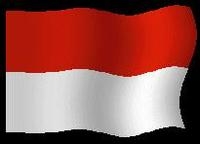
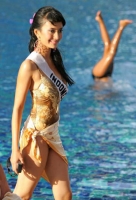
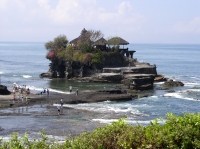
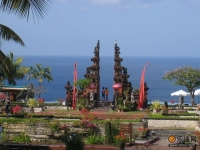
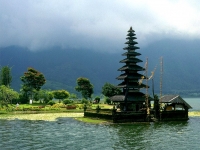

![旅游]异域风情的印度尼西亚--生活之友 风光旑旎的印度尼西亚
点击图片查看详情](http://oson.ca/upload/images11/cache/02405e15306906b62d7677065ccb9b7e.jpg)
